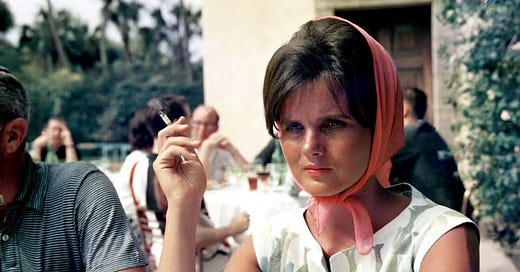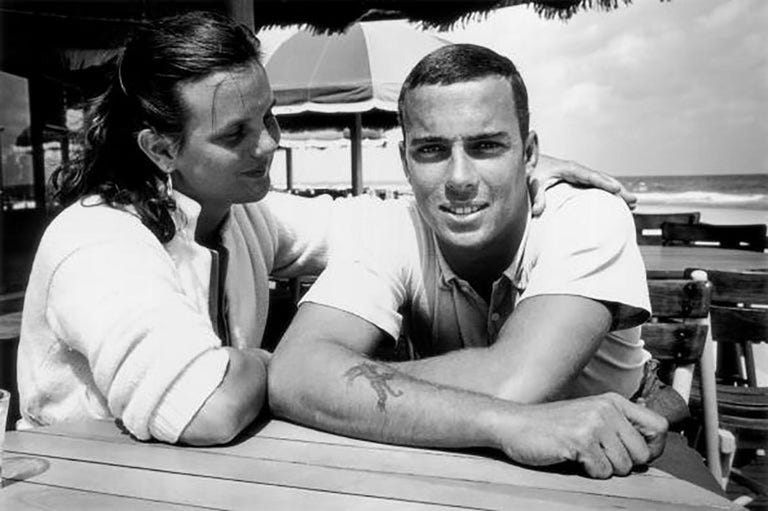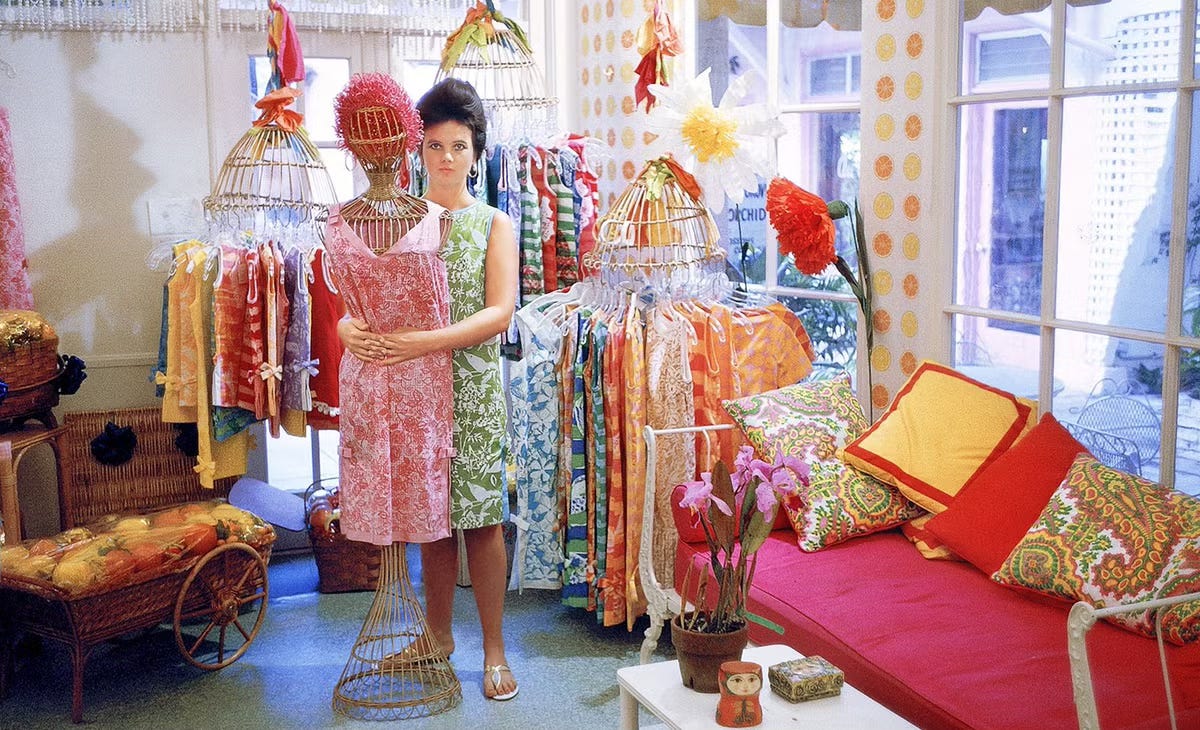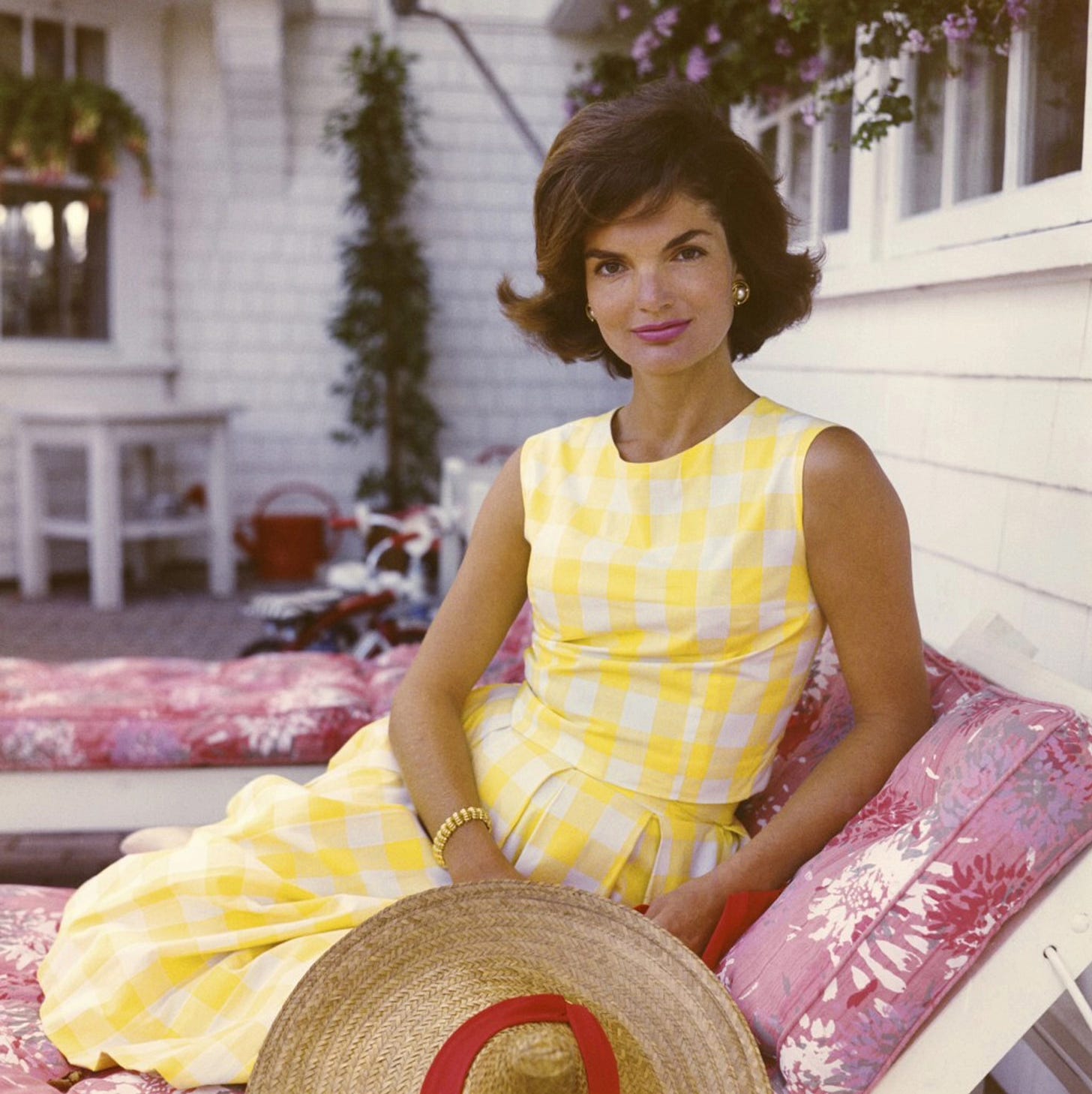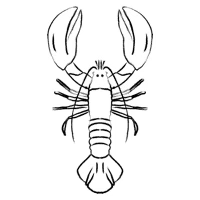“If you can’t be happy in a Lilly, you can’t be happy in anything.”
— Lilly Pulitzer
Lilly Pulitzer was a woman who turned fruit stains into a fashion empire and proved that joy is the ultimate accessory.
Born into New York high society, Lilly swapped debutante balls for palm trees, reinvented herself in 1950s Palm Beach, and became the patron saint of “dressing like a vacation.” Her story is a cocktail of citrus groves, serendipity, and prints so bold they could brighten a hurricane.
Table of Contents: Early Life & Society Roots / Meeting Peter / From Juice Stands to Jungle Prints: The Birth of a Brand / Jackie / Business Takes Off / Personal Life / Later Years
If you aren’t subscribed yet, hit the subscribe button below to receive the Adorable Stories every weekend, directly in your inbox:
Early Life & Society Roots
Lillian Bostwick McKim —known forever as Lilly— was born on November 10th, 1931 in Roslyn, New York, into the glittering world of Old Money.
Her mother, Lillian Bostwick (1906–1987) was the heiress of her wealthy grandfather, Jabez A. Bostwick (1830–1892), one of John D. Rockefeller’s founding partners in the Standard Oil Company.
Her father, Robert McKim (1895–1957), was a financier. The couple married in 1925 at the Church of Transfiguration in Manhattan.
They split their time between a beautiful estate in Roslyn, New York, and a summer “cottage” in Newport, Rhode Island, where they mingled with the Astors and Vanderbilts.
Lilly was the middle child, with older sister Mary Maude (called “Memsey”) and younger sister Florence Fitch (“Flossie”).
Lilly’s childhood was one of polo matches, debutante balls, and winters in Palm Beach. Her parents’ marriage, however, soon became strained. Robert struggled with alcoholism, and Lillian focused on Bostwick Field in Old Westbury, New York where they hosted international polo matches.
After their divorce in 1937, Lillian Bostwick remarried with Ogden Phipps, a member of the prominent Phipps family.
Lilly attended elite boarding schools, including Chapin School (NY) and in 1949, she graduated from Miss Porter’s School in Farmington, Connecticut, where she earned the nickname “Lilly” for her love of lilies of the valley, which she tucked into her hair and pockets.
“I’d throw tantrums if my nursemaid didn’t bring me fresh ones daily”
— Lilly Pulitzer
She attended the college-finishing school Finch College in New York City, but left after one semester to work as a midwife’s assistant in West Virginia and as a volunteer at the Veterans Hospital in The Bronx.
Meeting Peter
While vacationing in Palm Beach, 19-year-old Lilly met Peter Pulitzer (1928–1993, extensively featured in the Adorable Story #90) at a charity ball.
Peter, the Harvard-educated grandson of St. Louis Post-Dispatch founder Joseph Pulitzer II, was managing his family’s citrus groves in Florida.
They quickly became a couple and eloped in 1950.
The New York Times later dubbed it “the union of two American dynasties—oil and ink.”
After getting married, the couple moved to Palm Beach, Florida, where Peter managed citrus groves. They had three children: Peter Jr. (b. 1954), Minnie (b. 1956), and Liza (b. 1957).
From Juice Stands to Jungle Prints: The Birth of a Brand
In 1957, Pulitzer opened a juice stand on Via Mizner, just off Worth Avenue, Palm Beach, squeezing oranges from her then-husband Peter’s groves together with an acquaintance from New York, Laura Robbins, a former editor at Harper’s Bazaar.
The venture, dubbed “Lilly’s Fruit Stand,” was more a social club than a proper business: locals dubbed it “Lilly’s Lemonade Party.”
“I went crazy. I was a namby-pamby; people always made decisions for me. The doctor said I should find something to do.”
— Lilly Pulitzer
To hide juice stains, she asked family seamstress Margaret Donahue to stitch sleeveless shifts from colorful, washable cotton.
Her designs proved popular and, by 1959, she fully pivoted to fashion, founding Lilly Pulitzer, Inc., with prints sourced from the nearby Key West Hand Print Fabrics, a small studio run by her family friend Bill Mow.
“I got bored squeezing oranges, so I started squeezing rich people instead.”
— Lilly Pulitzer
Over 85% of Lilly Pulitzer’s prints were designed by Suzie Zuzek, the designer for Key West Hand Prints.
Their collaboration birthed iconic patterns like “Pink Elephant” and “Jungle Grub”.
At the time, her dresses cost USD 22 each —accessible for the era—and sold like “hotcakes at a Baptist picnic,” as Lilly put it.
Jackie
Jackie Kennedy, her former classmate at Chapin School, became an unwitting testimonial, after the First Lady wore a lime-green Lilly shift in a 1962 Life magazine spread.
The First Lady reportedly ordered six dresses, telling Lilly:
“Just make sure they’re not too tight—Jack hates me looking frumpy.”
Orders flooded in.
Business Takes Off
Soon, Lilly’s clientele read like a Social Register: Wendy Vanderbilt (photo below) wore Lilly’s shifts for some of her most iconic photo shoots, model Marisa Berenson accessorized them with Emilio Pucci scarves, and C.Z. Guest (extensively featured in the Adorable Story #14) wore them to walk her prize-winning dogs around Palm Beach.
The always-shy Lilly Pulitzer surprisingly leaned into the irreverence, hosting trunk shows where models danced with parrots and once trading a dress for a free haircut at her Palm Beach salon.
By 1965, sales hit USD 1.5 million annually (approximately USD 14M today). She expanded into menswear (tie-dye cabana sets), children’s clothing, and even a short-lived perfume line, “Pink Jungle.”
At its peak, her Miami factory cranked out 500 dresses a day.
“I designed collections around whatever struck my fancy... fruits, vegetables, politics or peacocks. It was a total change of life for me, but it made people happy.”
—Lilly Pulitzer
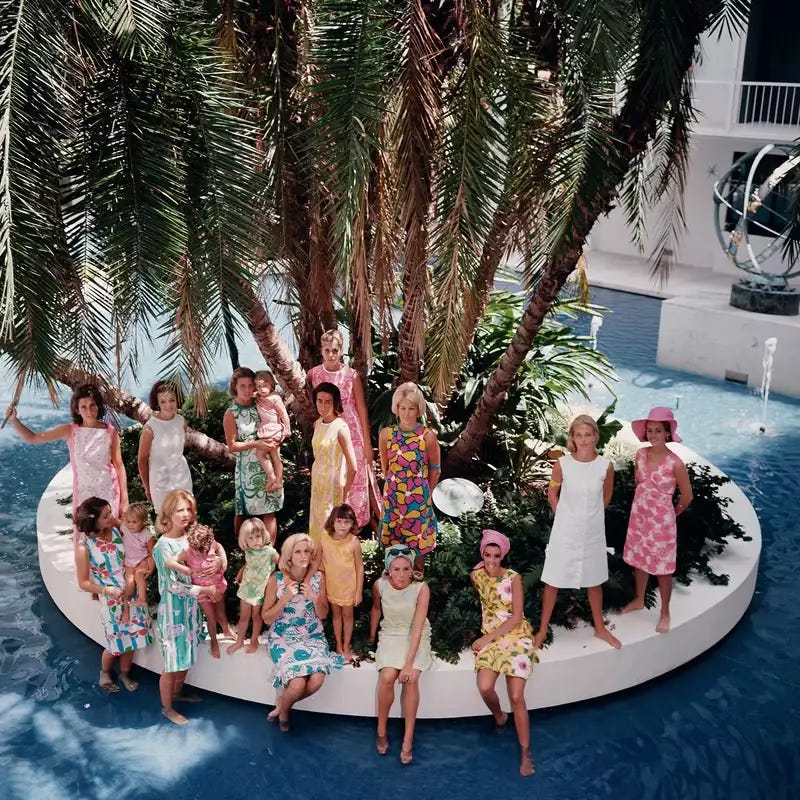
Personal Life
After divorcing Peter Pulitzer in 1969, Lilly married Cuban-American investor Enrique Rousseau in 1970. They split amicably in 1983 but remained close until his death because of cancer in 1993.
Her children inherited her free spirit: her daughter Liza helps with the Lilly Pulitzer brand and she is also part of a real estate firm in West Palm Beach, while Minnie (whose real name is Lillian just like her mother) produced a line dubbed “Mommy and Minnie” featuring maternity and children clothes.
Later Years
As sales gradually waned, Lilly Pulitzer retired in 1984, closing her company. But in 1993, rights to the brand were acquired by Sugartown Worldwide, which relaunched it with her guidance. By 2012, Lilly Pulitzer was back on its feet, developed into a USD 122M business, beloved by old and new generations alike.
Her aesthetic—carefree, unapologetically bright—reshaped American fashion.
The Metropolitan Museum of Art added her designs to its permanent collection in 2012.
After retiring in 1984, Lilly Pulitzer split her time between Palm Beach and her farm in Pennsylvania.
Ever the socialite, she hosted annual “Lilly’s Pink Tea” charity fundraisers, where guests sipped rosé from watermelon cups.
In April 2015, Target announced a collaboration with Lilly Pulitzer. Within hours, the collection was almost entirely sold out, in stores and online.
On April 7th, 2013, Lilly Pulitzer Rousseau died at her home in Palm Beach, Florida. She was 81.
—Alberto @
Do you know anyone who would love to read this Adorable Story? Show your support by sharing Adorable Times’ Newsletter and earn rewards for your referrals.


